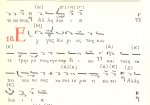Dear Aprilka:
You ask:
Is this matter, changing pa vu ga di, called parakordia, transposition ?
Not quite. PARACHORDI has a specific meaning (see later). When one places a phthora that represents the root of a tetrachord on the root of an existing tetrachord without altering the genus (like the phthora of Pa on Ke), one is essentially replacing an entire tetrachord with another, en bloc.
One can also replace a tetrachord of one genus with an entire tetrachord of another genus (for example, the tetrachord of the hard chromatic Pa-Vou-Ga-Di) in place of the diatonic Ke-Zo'-Ni'-Pa'). This is referred to as the METAVOLI TOU GENOUS (change of the genus). Again, an entire tetrachord is replaced by another en bloc. The phthora of the root of the chromatic tetrachord is placed on the root of the diatonic tetrachord (e.g. hard chromatic of Pa on the note Ke in a diatonic melody).
PARACHORDI is completely different in that a sequence of four intervals is replaced en bloc by a defined tetrachord of one of the genera. For example, if one were to place the phthora of hard chromatic Pa on Di of a diatonic melody, this is called the CREATION of a Parachordi. One is replacing the sequence Di-Ke-Zo'-Ni' of the diatonic genus with the tetrachord of hard chromatic Pa-Vou-Ga-Di. Or, another more "severe" example of replacing diatonic Ga-Di-Ke-Zo' with the tetrachord (with root Pa) of the hard chromatic genus.
You comment:
But between pa and vu there is big step in diatonic scale
And when I listen simonopetra it sounds like half step (Gis Ki ri os)
That is because of the "anomaly" created by melodies that revolve around Zo'. The interval is large, but acoustically, the pitches Ke-Zo sound closer. It's part of psychoacoustics. Again, you cannot use theory to reproduce what you hear or to base learning something. Theory without understanding and having received the oral tradition is useless (and dengerous and misleading).
You ask:
As for the diesis, if ZO is raised with replacing of PA VU GA DI
Why the need for first sharp on ZO ?
As I noted in my earlier response- The composers want to remind the chantor about the minutiae that the "anomaly" of Zo creates and that in practice, the performer needs to slightly raise Zo in a melody that revolves between Ke-Zo'-Ni'.
I hope this helps, but please try to find some help alongside a good chantor. I don't know where you are located in the world, but if you are close to Europe, North America or Australia there are a number of excellent people willing to help you without any financial burden imposed on you.
NG

